Mid-century house inspires Palm Springs-style garden in Austin
Charlotte Warren, a photographer and former co-chair of the local Garden Conservancy tour, inherited a steeply sloping, west-facing zoysia lawn when she moved into her home in the hills of West Austin. Aside from requiring lots of water and regular mowing, the lawn offered zero privacy for her front-yard swimming pool and did nothing to complement the mid-century lines of her 1957 Barton Riley-designed home.
Inspired by the Palm Springs, California-style architecture of her house, Charlotte hired landscape architect Curt Arnette of Sitio Design to create a garden in the modern, desert-oasis style for which Palm Springs is known. In the summer of 2013, the zoysia lawn was ripped out and the new garden installed. I visited just a couple months later, in October, to photograph it. Those photos appear in the first half of this post. But I have a treat! I was invited to visit again last week and took new photos, which make up the latter part of this post, offering you before-and-after views of the garden’s growth over one year.
Let’s take a tour, shall we? A small, emerald lawn still offers barefoot pleasure under the live oaks near the house and pool, a non-guilty pleasure considering the water thriftiness of the rest of the garden. Mod circles of crushed gravel act as stepping stones across the rubbly, native river rock that mulches the dry garden.
Where the zoysia lawn once crisped in the afternoon sun, now an inviting, steel-edged, crushed-gravel path sidewinds through the sloping lot, with steel-riser steps leading down and back up to the house.
Desert plants like Yucca rostrata, agave, and golden barrel cactus and drought-tolerant natives like Texas mountain laurel, Wheeler sotol, blackfoot daisy, prickly pear, Mexican feathergrass, and frogfruit create a buffer between house and street, hold the slope (no retaining walls were added), and lushly mingle to create a Cal-Tex oasis.
The pool is situated in front of the house behind turquoise railing, overlooked by the front windows for a year-round poolside view.
These steps lead down the slope, where the gravel path continues back toward the driveway. Enormous, rounded granite boulders, which look as pillowy as rising bread dough, edge the steps and are placed as accents throughout the garden. Along the property line, Arizona cypress creates an evergreen screen.
Graceful steps entice you to keep exploring.
On any sloping lot, water runoff is a design challenge. Terracing is one answer, but it’s expensive. In this unterraced garden, boulders help slow water flow as do the plants, and a channel filled with riprap collects remaining runoff, ducks under a metal bridge in the gravel path, and moves it downhill off the property.
Xeric plants like ‘Macho Mocha’ mangave and Mexican feathergrass are given room to grow and spread.
Blackfoot daisy spills over and softens a cluster of boulders.
Looking up from the street. The white-flowering tree at right is Mexican olive (Cordia boissieri). Because it’s native to South Texas and can be damaged in hard freezes, this is one tree I’d plant in spring rather than fall.
It is quite pretty.
At street-level, Mexican feathergrass mixes with agave, mangave, sotol, leatherstem (Jatropha dioica), and blackfoot daisy.
The golden eye of blackfoot daisy finds a color echo in golden barrel cactus.
One year later: August 28, 2014
That was then. This is now, one year later, on a sunny, 100-degree summer afternoon. Despite the heat, a breeze kept me comfortable, and the winding path is as enticing as ever.
The groundcovers and grasses have put on the most growth over the past year. The native shrubs and small trees have also noticeably grown. Other plants have been replaced, as is typical in any garden. A shrub along the top path, for instance, has been replaced with the cleaner lines of an ocotillo, a desert plant I don’t see in Austin very often.
The switchback. Architectural Yucca rostrata serves as a focal point at the turn.
The Texas mountain laurels have grown a foot or two, and will eventually screen the left side of the pool.
Yucca rostrata shadow play (“Look at me! I’m a sun!”) on a puddle of silver ponyfoot.
A new perspective, looking down the steps. Notice that much of the gravel mulch is now hidden under a layer of creeping groundcovers, softening the look of the garden.
The steel bridge and riprap channel. I imagine this becomes a torrent during a typical Texas thunderstorm.
Looking back at those pillowy boulders and shimmery Yucca rostrata.
One more view, with the bridge. Blue-greens and silvery blues visually cool the garden, plus those plants tend to be most drought-tolerant.
Powder-blue Wheeler sotol dances uphill on either side of the riprap channel.
Yucca rostrata should always be planted where it can cast a shadow.
‘Green Goblet’ agave sits atop granite boulders, with golden barrel cactus below.
The garden continues in a curving band on the other side of the driveway. It makes for a continuous garden view at the juncture of strolling path and driveway.
Water runoff along the driveway is handled with another channel and heavy stone that won’t wash downhill.
At streetside, groundcovering Mexican feathergrass and frogfruit have filled in nicely, and the feathergrass has gone tawny for summer. The structural agaves grow more slowly, but in a few years they will dominate this scene.
On the right side of the drive, silver ponyfoot cascades around boulders and plants like a living waterfall.
Up near the house, a trio of large steel-pipe pieces act as planters for silver and bronze dyckias.
A silvery-green, textural composition of ‘Whale’s Tongue’ agave (A. ovatifolia), purple prickly pear (‘Santa Rita’ opuntia, perhaps?), and silver ponyfoot (Dichondra argentea).
My thanks to Charlotte for inviting me back to see how her garden has grown. It’s heartening to see a garden that looks just as happy after weeks of triple-digit heat and no rain as it does in fall or spring. Charlotte told me she waters once a week via a drip system that delivers water directly to each plant. I imagine by next year, the dry garden could easily go two weeks between waterings in summer and look just as fantastic, and of course it wouldn’t need to be watered at all in cooler, wetter times of the year.
All material © 2006-2014 by Pam Penick for Digging. Unauthorized reproduction prohibited.


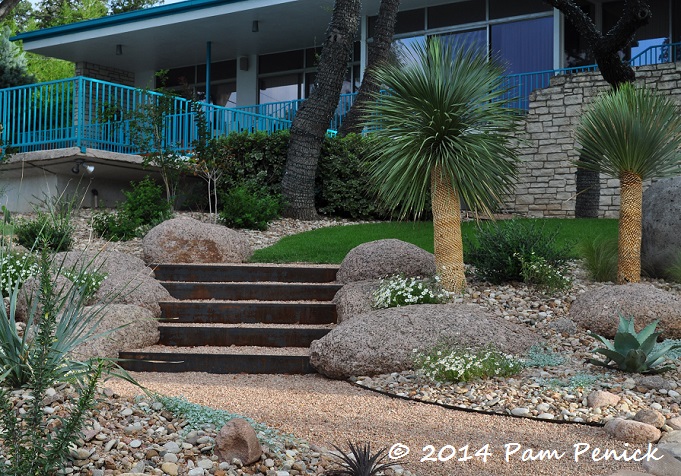
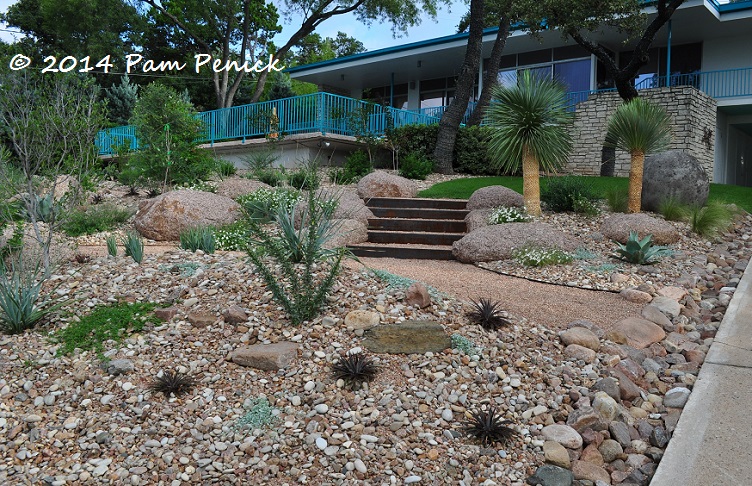
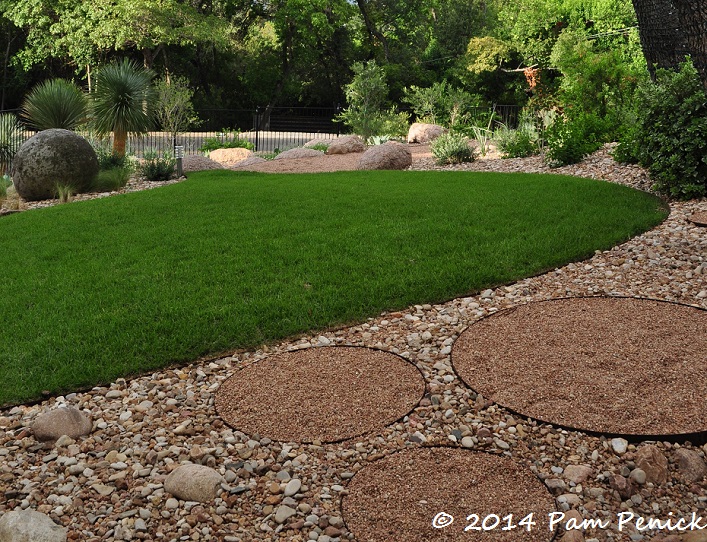
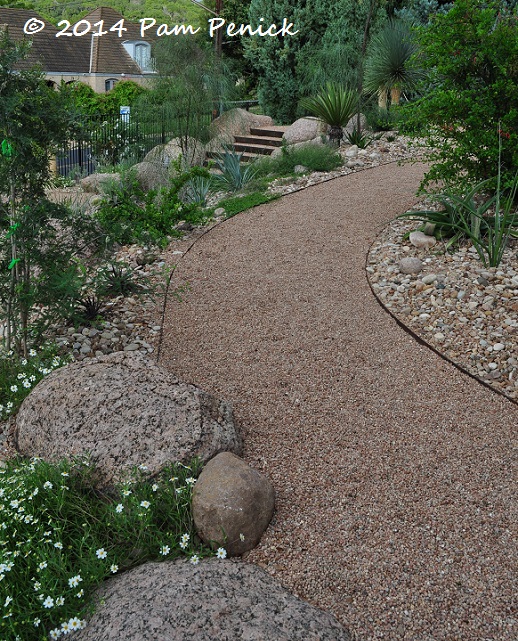
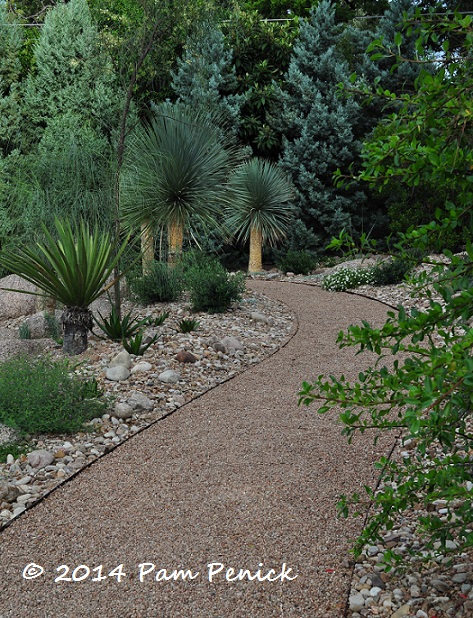
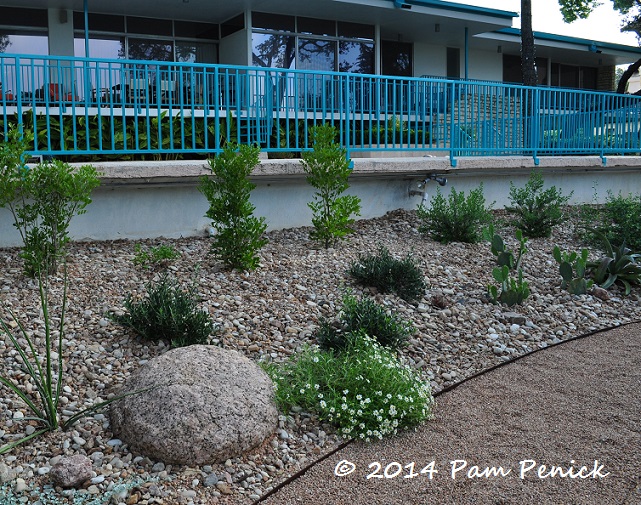
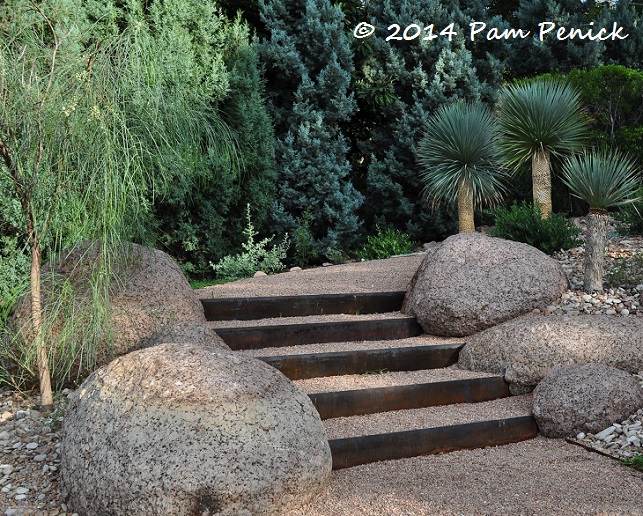
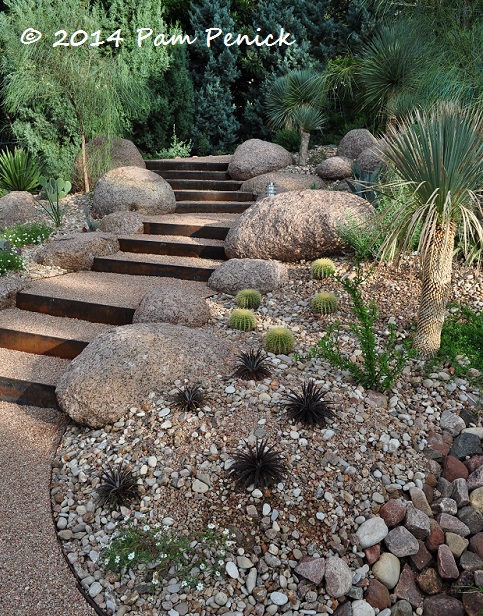
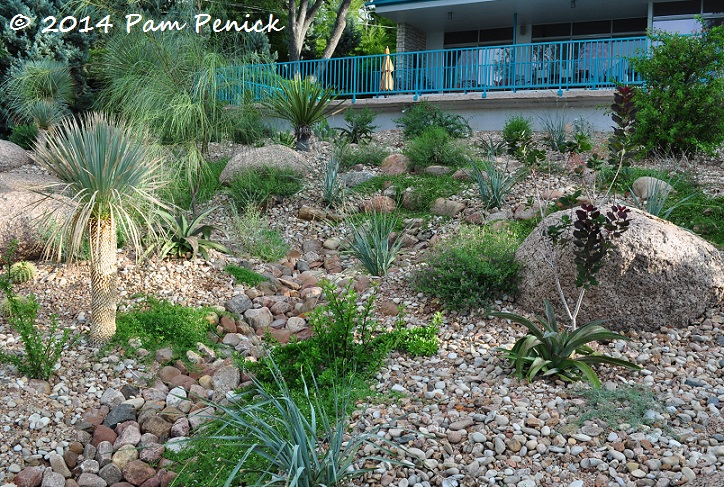
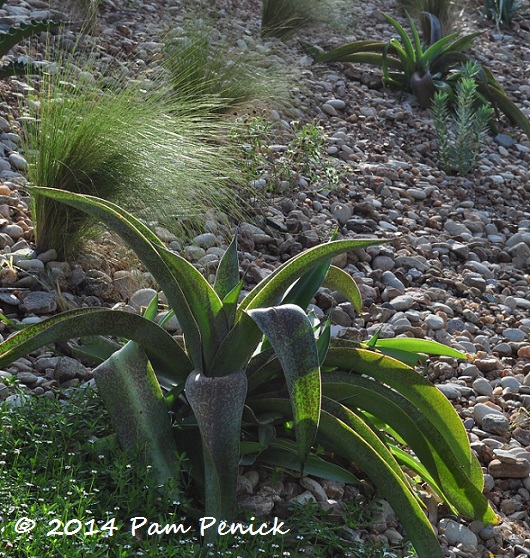
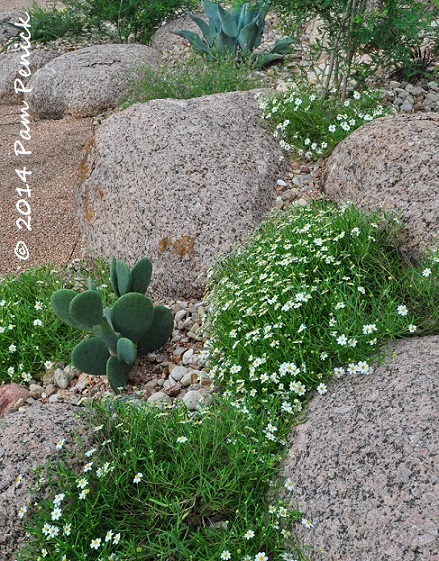
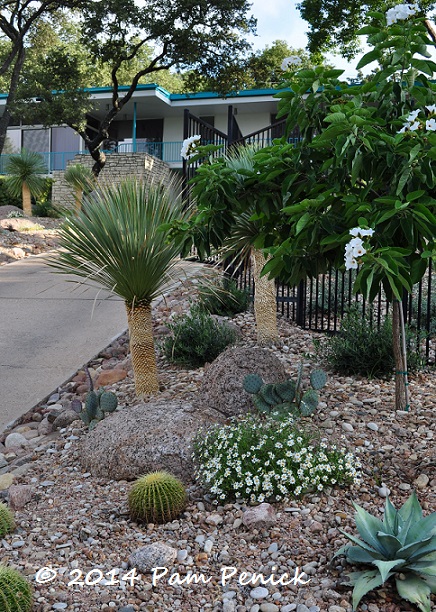
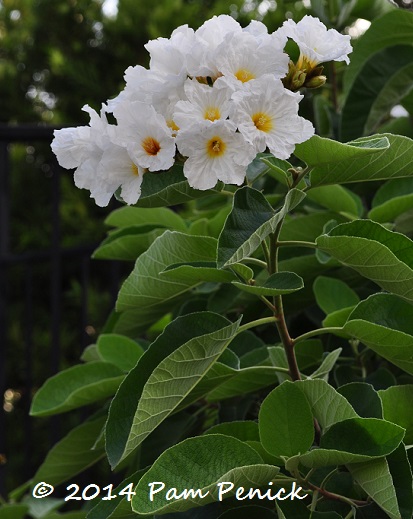

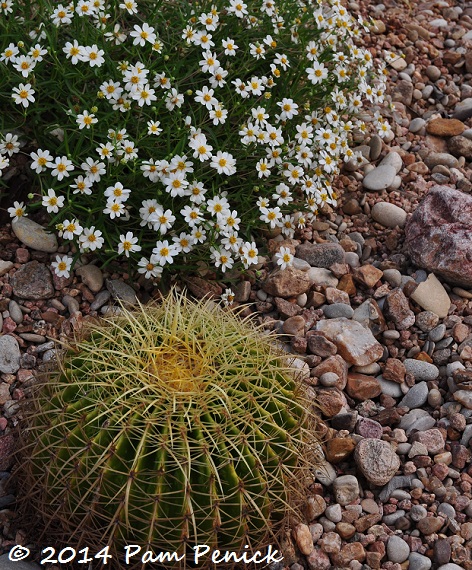
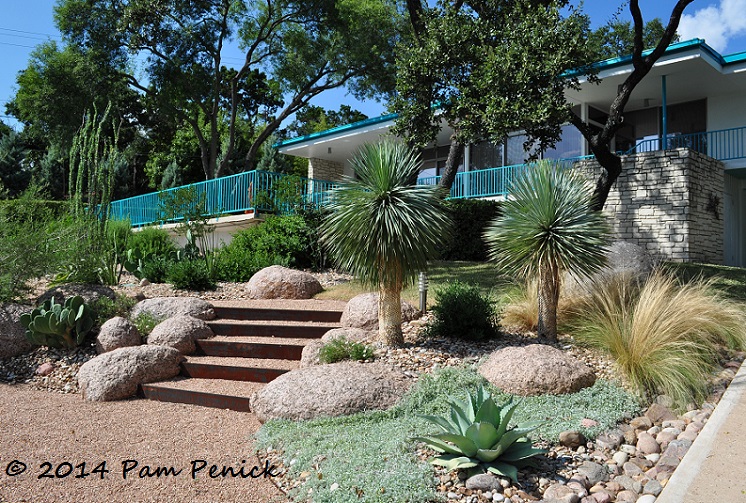
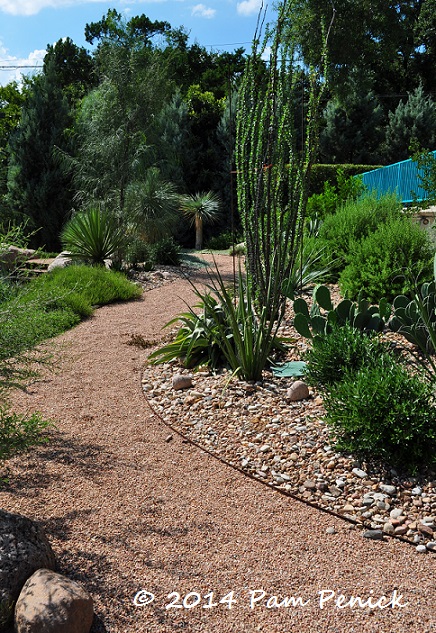
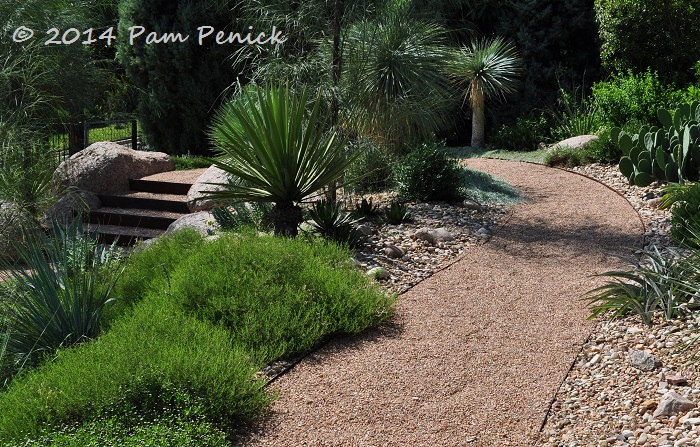
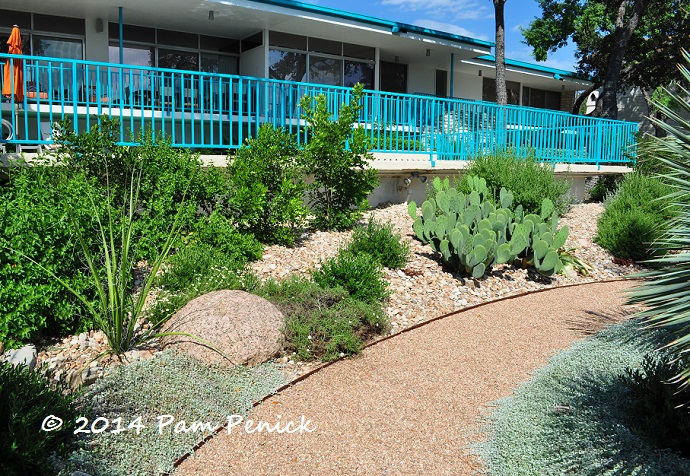
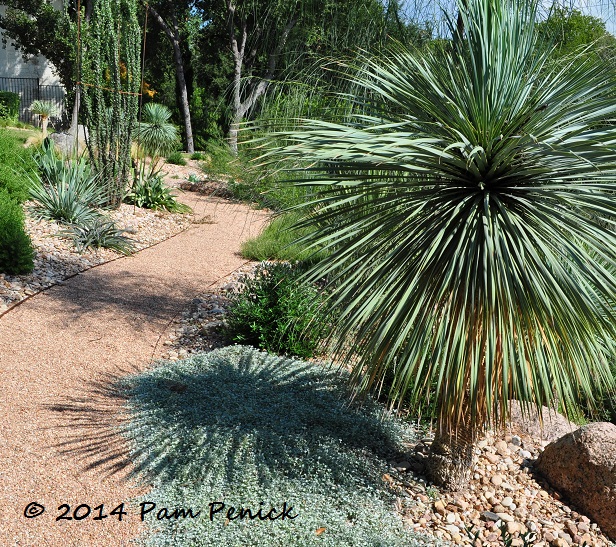
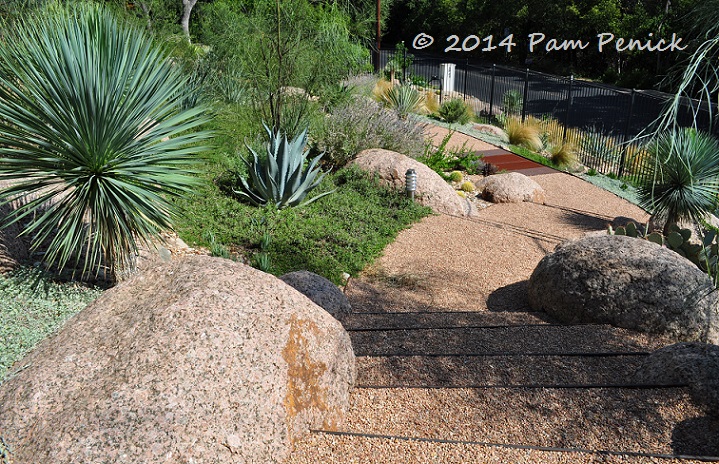
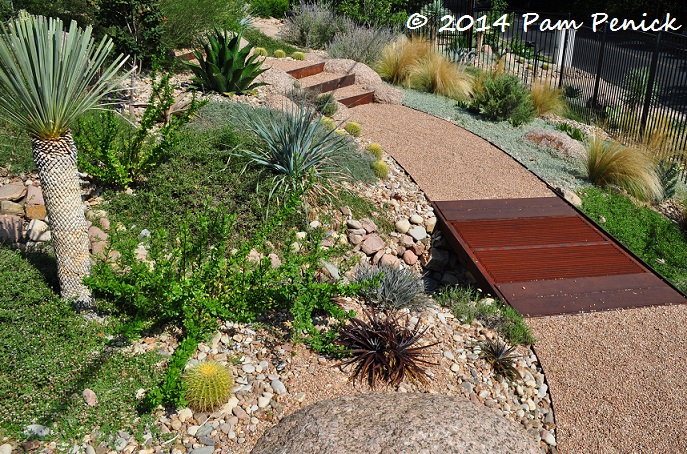
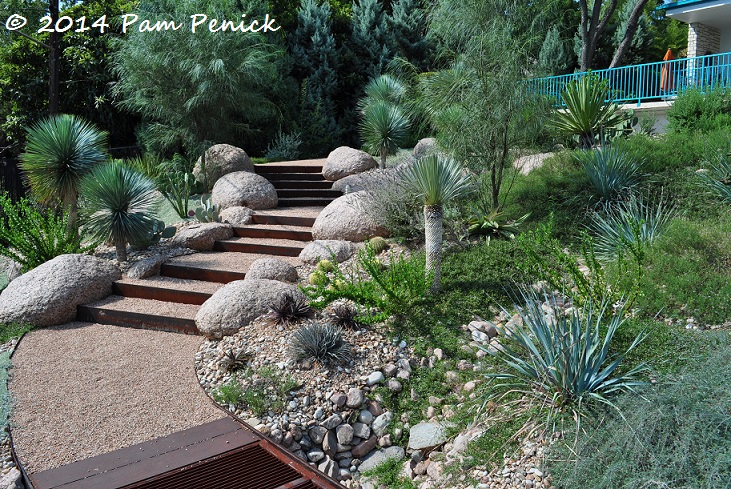
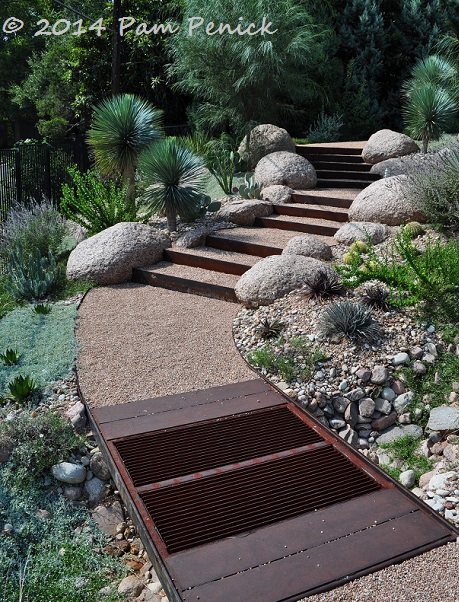
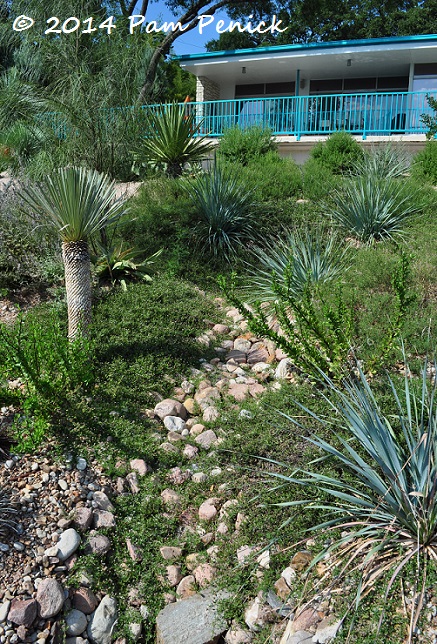
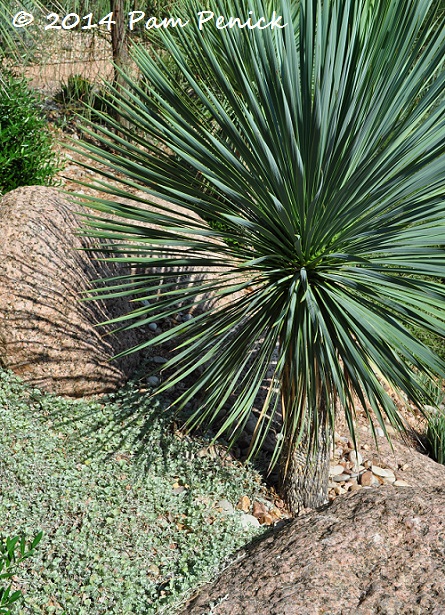
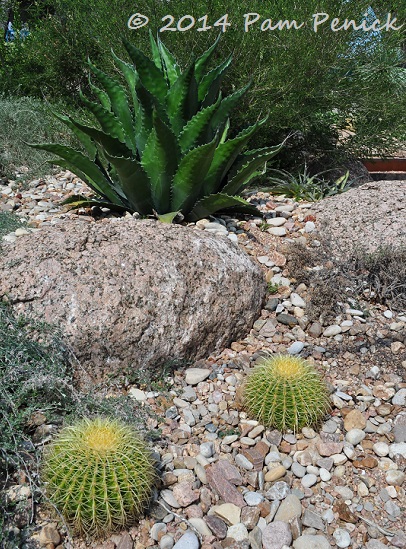
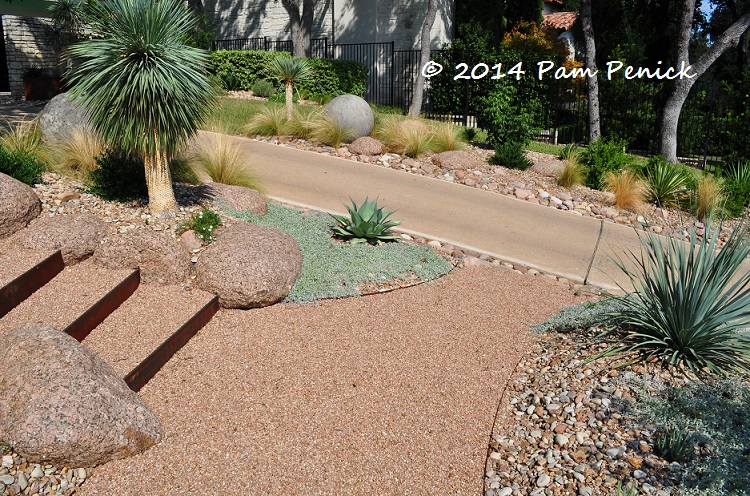
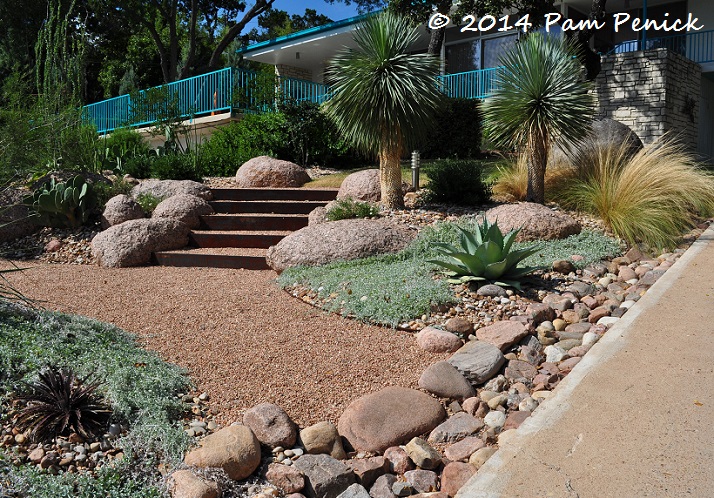
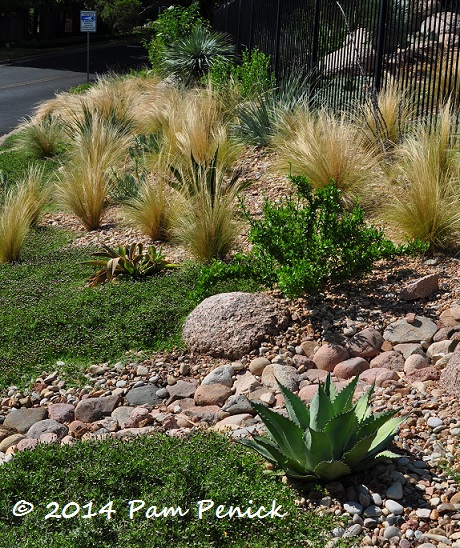
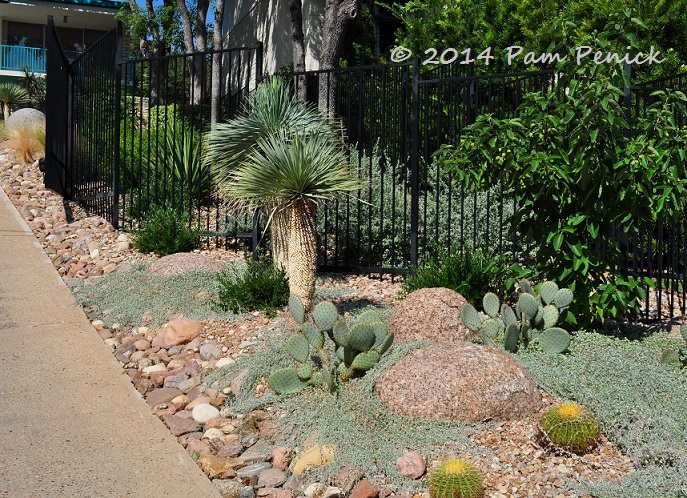
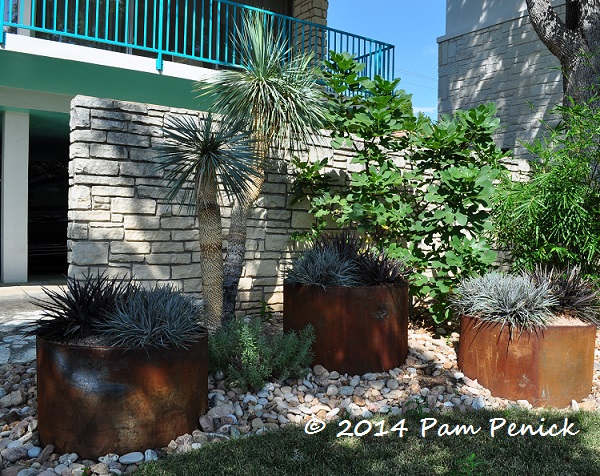
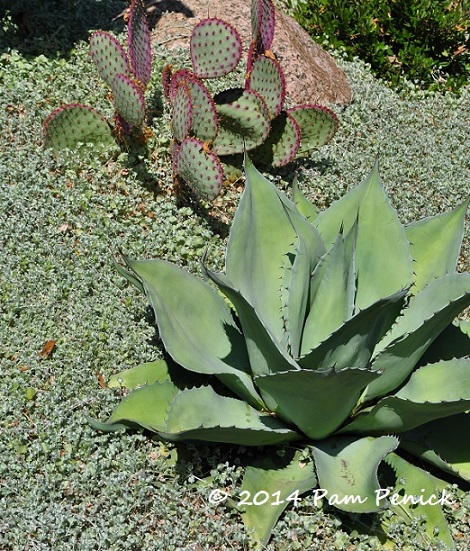
What a handsome garden. I love the flow of the gravel path through those prickly, architectural plants. Perfect. I also like reading ‘frogfruit’. I am not sure which plant it is but it sounds happy. This garden is very Hollywood to me. 🙂 This is a good thing by the way.
Lisa, frogfruit (it does have a cute name, doesn’t it?) is the groundcover in the 4th photo from the bottom. —Pam
so lovely! Doesn’t the Dichondra need more than once a week watering though? I seem to have trouble getting it going here in Sacramento… then again, maybe the deer have eaten it. This yeard certainly does look more like Southern Cal or Phoenix than Austin… its very nice. (would love to tour the house!)
Cheryl, the owner told me she waters once a week on drip, and since there’s so much Dichondra throughout the garden, I guess it does fine on that. I have heard that deer will eat it though. —Pam
Great garden, thanks for sharing your two years’ worth of photos, that made for a very interesting post. I really need a Yucca rostrata.
I’m glad you enjoyed the tour, Alison. It was just a year (10 months, actually) between my visits, but there’s been a good deal of growth in that time. Probably our relatively rainy spring and late summer helped get this garden going so quickly. —Pam
Man, this is GORGEOUS. I love it! And it’s such a difference after the groundcovers have filled in and covered up the gravel.
I think this garden really demonstrates the power of using creeping, spreading groundcovers. They soften and green up even a xeric garden such as this one. —Pam
Really nice garden. The lawn in the “year later” picture evokes a more Palm Springs vibe, where the lawns are mostly and appropriately yellowy-brown Bermuda. What a star Y. rostrata is!
Isn’t it a show-stopper when used en masse like this? And completely cold hardy, unlike so many agaves. —Pam
This garden is stunning! I love seeing it more grown in. It really does suit the house. And does remind me of the southern California desert. Thank you for the tour!!!
My pleasure, Laurin. I’m glad you enjoyed the tour. —Pam
Thanks so much for this post; these garden visit types, drive-by’s and more in-depth designer reviews are my favorite posts. And the year over year photos give this one a wonderful depth. This fellow who you’ve published many gardens from is certainly one consistently talented designer no matter what the challenge. Time to start thinking of a monograph for this guy. Thanks for a wonderful blog.
Walt, what a nice comment! Thank you. I’m so glad to know you enjoy my in-depth tours. I spend a lot of time on them because I enjoy sharing the gardens I get to visit, but also because thinking about how they’re designed makes me a better designer — and gardener — myself.
Yes, Curt Arnette is a very talented designer. And more than that, he’s one of the nicest guys I’ve ever met. —Pam
Very impressive. It’s heartening to see what can be done with a desert style landscape and a great eye. Thanks for the tour, Pam.
My pleasure, Kris! —Pam
It is wonderful to see the ways that sizes and colors of gravel/rock chips can be used, for example, the round stepping stones. Ocatillo offers its tall spire shape and gorgeous red bloom. But if it is too cold, you may lose it. Thanks Pam for your pictures. I always enjoy seeing them.
Ocotillo is one of those charismatic desert plants that lots of Austin gardeners want to grow, but it’s tricky here. I didn’t think it was the cold so much as a humidity and soil-drainage issue, but either way it’s a challenge. I’m glad you enjoyed the tour, Sandra. —Pam
Pam – Great photos and narrative as usual. This project would not have been possible without the vision of Charlotte Warren and the construction expertise of the landscape contractor, John Gibson.
Both were a pleasure to work with.
Curt, as you say, successful designs are usually a happy collaboration. And then there’s ongoing maintenance, which is also crucial. —Pam
Wow – I love this garden! So tidy, structural, elegant and un-thirsty. And that’s such a great pic of the Yucca rostrata’s shadow giving the dymondia a little afternoon shade. Beautiful as always, Pam.
Thanks, Rebecca. I think I could have done a whole post on the shadows in this garden. The yuccas are shadow masters! —Pam
Curt dazzles again! I’m so impressed by his ever-amazing usage of texture and varying green tones. How can a landscape outfitted with so many ‘rocks and pokey things’ look so pillow-y and lush? I wish I had a tenth of his vision.
It is interesting how rocks can be used to create a soft look. These rounded granite boulders are unusual for Austin gardens. We more often see rough-edged limestone. —Pam
Wow! This was certainly a treat, what a “stop and stare” garden. It also shows that my experience with Dichondra not spreading as a ground cover was an oddity. I wish I had gotten those pools of silver in my garden.
Two questions…is there a back garden, if so does it continue the theme? And is the transition from wide pathway to driveway (over some big rocks seemingly blocking the path, see the 5th photo from the bottom) really as jarring as it looks here? The path seems to invite wandering and then you’re told to stop and turn around or jump to the driveway.
Good questions, Loree. I only got a passing peek at the back garden when I parked in the driveway. It looked to be mostly lawn shaded by large perimeter trees, but I think the owner mentioned a pond, so perhaps there’s more than I could see. However, the back yard sits above the grade of the driveway and was mostly hidden from view. I was invited to visit by the designer the first time, to shoot pictures for his portfolio, and I guess he only designed the front. The owner kindly invited me for a revisit recently to see how it had grown.
Where the path intersects the driveway, the river-rock-filled gap is about a foot wide, and I simply stepped over that onto the larger, pink rock you can see in the picture. So yes, there is a gap, but it didn’t seem particularly jarring. Another metal bridge might be nice to span the gap though, especially if anyone with mobility issues were to visit.
I’m glad you enjoyed the tour. I thought this one would be right up your alley. —Pam
I like the combination of naturalism and glamour.
That’s a good way to describe it, Cindy. —Pam
Pam I really enjoyed the first and second year views of this amazing garden. I love seeing landscapes that are natural looking and the plants certainly are enjoying their home as they have grown and spread beautifully.
I’m glad you enjoyed the tour, Donna! —Pam
Wonderful to see an inviting garden full of interest that is prepared for the 100-degree, full sun in Austin. Love that the ocotillo was added, which has a texture like nothing else. I am surprised that you can use feather grass — such an invasive problem child here.
I’m happy that feathergrass is not on our invasives list. It’s native to West Texas, and though we’re not as arid perhaps Austin’s summer heat and frequent droughts keep it from becoming a pest, as I know it can be in California. —Pam
Fantastic and I’m sure very expensive!
Good design is never cheap. —Pam
Hi! I plan to link to this on an upcoming Texifornia roundup post, and I was wondering if I could use one of the pictures with it (watermark included)?
Gale, I’ll email you. —Pam
Hi Pam. Appreciate that you are such an active & dedicated blogger. I keep coming back because I know you always have new information and great photos. None of this “I’ll post every 4 months” for our Pam!
Ha — no, I have too much to say for that. Thanks for visiting and for your kind comment. —Pam
I love how much this garden has going on!…and everything looks so great together. I have been thinking more and more about a ‘legit’ drip system….I lost some plants this summer 🙁
That happens every summer for me, Heather, probably because I insist on moving my plants around so much, so there are always some transplants struggling to get through summer. Ah well, it just opens up space, right? —Pam
Just amazing how lush this garden is and perfectly suited to the architecture! I enjoy learning by looking at examples, and your in-depth garden explorations strike such a perfect balance of beauty and information.
Thanks, Vicki! I learn a lot from writing these posts too. —Pam